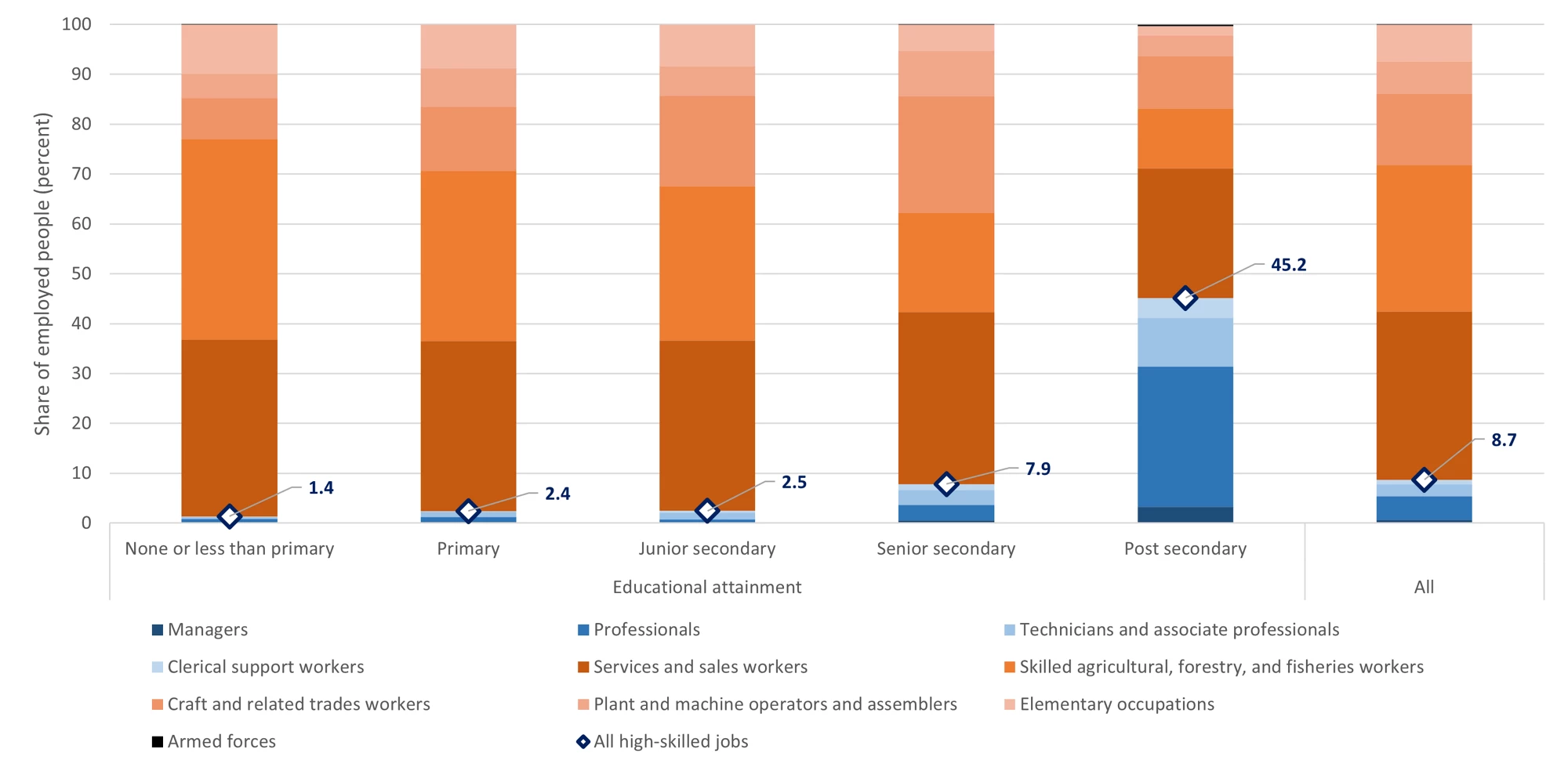 Photo: Yan Krukau/Pexels
Photo: Yan Krukau/Pexels
Almost three years after the start of the pandemic, we are just beginning to get a clearer picture of how the labor markets in South Asia have evolved. Many aspects of employment are ‘structural’ in nature, which means we cannot tell whether changes we observe now are temporary or permanent. In the World Bank’s latest South Asia Economic Focus, we tried to piece together emerging trends based on the limited evidence available, first by looking at changes in employment across sectors, and then by focusing on two demographic groups most vulnerable to job losses: female and youth workers.
The first order at hand is to use the data on recovery by sectors of economic activity to see what may have happened to employment growth and how it varied by sectors. The sectoral variation reflects the severity of lockdowns in each country and is influenced by whether the sector was contact-intensive or amenable to remote work, as well as by the duration and persistence of COVID-19 waves in a locality.
In the case of South Asia, the agriculture sector was less affected, while manufacturing recovered within a few months. However, there was huge heterogeneity in the recovery of the services sector. The figure below shows the case of India and is reflective of trends in other countries across South Asia. For example, growth in ‘business services’—comprising professional, financial, and real estate services—and in public services soared. In contrast, growth in contact-intensive (“COVID-sensitive”) services, fell sharply. The latter are services in the tourism industry—accommodations, restaurants, recreation, and entertainment—and personal services. People here were likely out of a job for a long time. As of the end of 2022, activity in these sectors was recovering but it is generally nowhere near pre-COVID levels.
The one trend that’s clear in employment across South Asia is that the recovery in labor markets remains incomplete as South Asian countries cope with a series of global shocks such as the economic impact of the war in Ukraine.
Predicting patterns of employment
Next, we use pre-COVID data on economic activity and labor productivity by sectors from the latest labor force surveys to ‘nowcast’ employment by sector as of mid-2022 (see figure below) and various patterns stand out:
- The good news is that employment in agriculture, manufacturing, and wholesale trade sectors were only affected for a few weeks when lockdowns began in April 2020. The majority or 92% of South Asians work in these sectors. Therefore, disruptions to employment were minimal and unlikely to impact long-term productivity, as they were able to return to work quickly.
- The not-so-good news is that the three services subsectors that grew the fastest during the same period—non-contact intensive ‘business services’, and some public services—also happen to be sectors with relatively low labor intensity and wages and high skill requirements on average, suggesting widening disparities in earnings compared to pre-COVID levels. Therefore, income inequality increased and the post-COVID recovery was not inclusive.
- The figure above is a ‘nowcast’ which assumes that all workers came back to their jobs quickly and at the same level of productivity as pre-COVID. Yet, we know this is not the case due to ‘scarring effects’, defined as the inability of a worker to be as productive as before. This could be due to new family responsibilities or health reasons or because they had to sell productive assets during lockdowns to cope.
Employment recovery for female and young workers
The COVID-19 pandemic pushed two of the most disadvantaged groups out of work: women and youth. Here’s how they fared in the post-pandemic job scenario:
- Women and youth had not returned to the workforce at the same rate as men and their elder peers according to the CMIE survey for India conducted at the end of 2021, when the labor market was still recuperating from pandemic waves. Analysis using this survey shows female labor force participation during September-December 2021 remains low compared to its pre-pandemic level, at about 9%. The statistics show that many Indian women, both in the urban and rural areas, shifted to more casual work compared to before the pandemic as of the end of 2021. The share of female permanent workers decreased, suggesting that many women withdrew from permanent salaried jobs. As schools gradually opened around mid-2022, female employment could bounce back to pre-COVID levels, as has been observed in other countries. Evidence from COVID phone surveys for Bhutan, Nepal, Pakistan, and Sri Lanka shows clear improvements as early as mid-2021.
- Shift to more casual and temporary jobs: To cope with the crisis, many young Indian workers (less than 25 years old) shifted to more casual and temporary jobs , which do not guarantee secure earnings. In 2021, most of the employed youth in India worked in occupations such as helpers, agriculture and plantation workers, sales assistants, and shop attendants—relatively less productive and commanding less wages.
- More recently, the share of permanent salaried jobs in total jobs in India—where employment data is more updated in the region—has increased and is close to pre-pandemic levels. Over 8.5 million salaried jobs were added cumulatively during September and October 2022, mostly in urban areas, though there is a concentration of job losses in the services sector in rural retail trade.
- Despite scarring, it’s not all bad news as there are positive structural trends which bode well for the long term. This is because women are more likely to be willing and able to work from home as they also tend to be the primary caregivers, and jobs that are home based provide important opportunities in the fast-growing market-oriented services sectors such as e-commerce. Also, data shows that youth in South Asia were already working in larger proportions in manufacturing and non-contact-intensive services sectors before the pandemic, and both women and youth relish and value the new flexibility of working hours that many jobs, especially those in digital technologies, can provide.
Looking ahead
Since the recovery of South Asia’s employment market is not complete, policymakers in the region can help reduce the long-term effects of the scarring by ensuring that sectors and firms that have less viability post the COVID-19 pandemic are not protected or ’propped up’. For example, extending credit forbearance to a large state-owned firm shifts public resources away from new firms and startups with huge growth potential. Instead, these resources could be used for regional service centers that provide job-matching infrastructure, training, and IT assistance to workers, thus reducing the cost and friction of switching jobs and transitioning to new sectors.





Join the Conversation